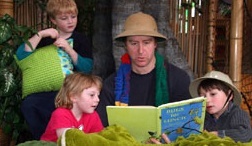Mastery, Part 1
Isn’t it a wonderful thing when you witness someone doing something they were just designed to do? Think of masters of their art: musicians, actors, singers, dancers. Or in sports, think of people like Michael Jordan. There seems to be a match between who they are and what they’re doing, such that the lines between the person and the activity get blurred. You stop seeing a person doing something and start seeing a single phenomenon, beautiful in its purity. There’s no part of the art that isn’t engaged by the person and there’s no part of the person that isn’t engaged by the art. They’re doing what they were made to do. I’m sure you can think of lots of examples.
Here’s an example that I liked, Jason Mraz singing “I’m Yours” live in Korea. You can tell that he chose the right career (and of course millions of fans agree).
In every case that I can think of, in addition to the aspect of full engagement, another essential element is play, or playfulness. This is sometimes more explicit in the case of improvisational arts. But even in highly structured contexts, such as a pianist performing a piece of classical music or an actress performing her lines, there is so much that can be improvised, if not the notes or the words themselves. The master has a freedom that they’ve built up from their talent and discipline and hard work, such that now it looks effortless, and they can experiment in the moment, playing with possibilities, trying things out, exploring new pathways.
Another aspect: seemingly endless reserves of energy. These performers just keep on going and going. Encore after encore. I have a neighbor who is studying tap dancing in New York City. He was made for his art. I can’t believe how long he can keep dancing in a single evening. His shirt might be drenched with sweat, but he keeps going and going, drawing energy from the enthusiastic crowd.
So how does one reach one’s full potential? How can we help kids have experiences like this? How can we find out what activities, or art forms, or sports, or careers will match up with who they are? More importantly, how will they find out what fits them, what they enjoy doing, what they’re good at doing?
How does someone like Guy Sidora invent a new art form, a new way of teaching, a completely unique career not heretofore invented? A combination of speech and bouncing balls and sound and movement that perfectly fits who he is and what his talents are.
First, my hypothesis: practice makes perfect. More specifically, if you can create experiences like the above for yourself, you should keep on doing it and let it develop fully into the particularities of who you want to be and what you want to do. If we can identify moments like the above in the lives of children, we should see to it that they keep on with it. They’re on the right path to mastery. They’ve captured the structure of the experience, even if they’re still exploring what details will ultimately work best for them as they approach adulthood.
So, before returning with part 2 of this article, I’ll leave you with a question to ponder: When do you ever see kids fully engaged, playful, free, and having endless reserves of energy?
It looks like you're new here. You may want to sign up for email alerts or subscribe to the "Lenz on Learning" RSS feed. Thanks for reading.


